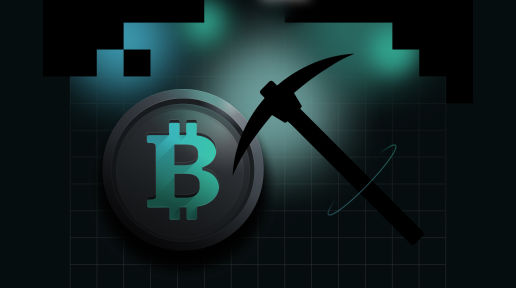As the world's first blockchain and cryptocurrency, the concept of cryptocurrency mining was born from Bitcoin's inception and has since become a crucial component of any blockchain's infrastructure.
But what's the process for mining even just one bitcoin, and what would you need to become a bitcoin miner? Our Learn Center will walk you through everything from mining costs, what Bitcoin mining involves, and what you need to complete the mining process and start Bitcoin mining.
Bitcoin Mining: A Definition
In short, Bitcoin mining is the process of verifying and adding new transactions to the Bitcoin blockchain.
It involves a decentralized network of computers competing to solve complex mathematical problems through a unique consensus mechanism known as proof of work (PoW). Miners use their computational power to find solutions, and the successful miner then adds the solution and verified transactions to the blockchain. The winning miner is rewarded newly minted Bitcoins and transaction fees for their efforts.
This process ensures the immutability of the Bitcoin network and prevents double-spending.
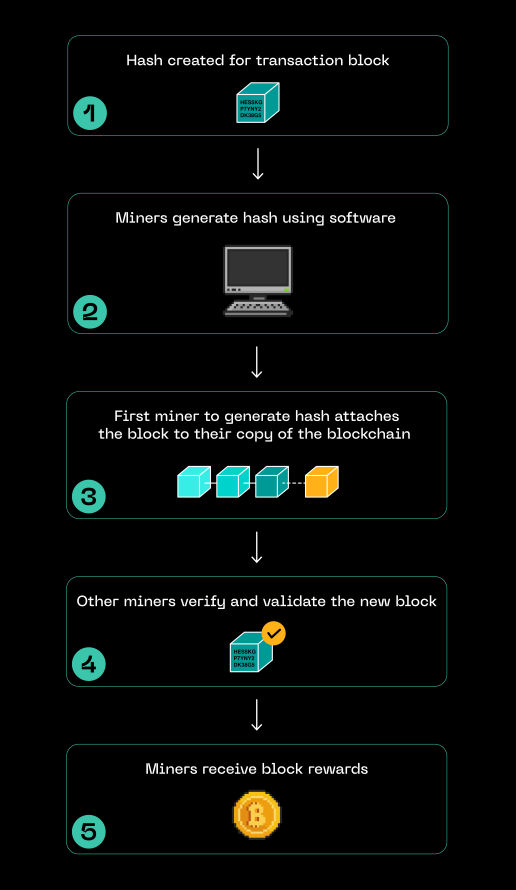
Source: Trust Machines
How Does Bitcoin Mining Work?
The process begins with miners collecting pending bitcoin transactions and organizing them into blocks. These pending transactions remain in the mempool until transactions are validated. Each block contains a set of transactions and a reference to the previous block, forming a chain-like structure known as the blockchain. To add or create a new block to the blockchain, miners must solve a computational puzzle.
Miners are required to find a specific value, called a nonce, that produces a hash with specific properties when combined with the data in the block. Finding this value requires significant computational power and is a computationally expensive process. Once miners find a valid nonce, they broadcast the block to the network, and other miners verify the solution.
The network of miners follows a majority consensus mechanism, where the longest chain with the most cumulative computational work is considered the valid version of the blockchain. Miners continually compete to extend the longest chain by adding new blocks, which strengthens the network's overall security.
Miner participation is incentivized through block rewards and transaction fees. The first transaction in each block, also called the generation transaction, creates new bitcoins and rewards the miner who successfully added the block to the blockchain. Transaction fees paid by network users also contribute to the incentives for miners.
How to Mine Bitcoin At Home and Bitcoin Mining Setups
Initially, Bitcoin mining could be done using Central Processing Units (CPUs) commonly found in regular computers. Miners would run Bitcoin software on their computers and use the CPU's computational power to solve Bitcoin's algorithm and mine new blocks. The mining difficulty was much lower, and the network was not as competitive, allowing individual miners to mine Bitcoin using their computers with decent CPU power.
Unfortunately, those days have faded as Bitcoin mining shifted towards using cutting-edge hardware to ensure energy efficiency and the ability to perform calculations as quickly as possible to remain competitive. Below, we'll discuss what is required for the Bitcoin mining process in today's landscape.
Mining Hardware
The "building blocks" of mining start with Bitcoin mining equipment. The number of network participants has grown substantially since Bitcoin's inception, and as a result, the competition to solve complex mathematical calculations has developed in tandem. This makes the need for efficient Bitcoin mining hardware crucial.
In early 2013, Application-Specific Integrated Circuits (ASICs) quickly replaced CPUs and GPUs as the de facto miner. ASICs are purpose-built machines designed specifically for Bitcoin mining and offer significantly higher hash rates and energy efficiency than CPUs or GPUs, making them the preferred choice for mining due to their computing power.
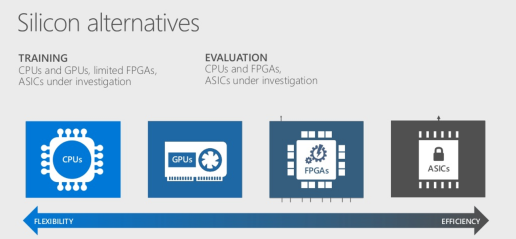
Source: Microsoft
CPUs and Graphics Processing Units (GPUs) offer substantially more flexibility than ASICs enabling users to mine various other cryptocurrencies. ASIC miners sacrifice flexibility for efficiency since the code that solves Bitcoin's mathematical puzzle is effectively etched into the hardware, making it difficult to repurpose the ASIC for anything other than Bitcoin mining.
On the other hand, Field Programmable Gate Arrays (FPGAs) are more efficient than CPUs and GPUS. However, they require specific coding architecture and customized code to make mining efficient. Ultimately, FPGAs have a higher barrier to entry as it requires specialized programming skills and technical ability to build.
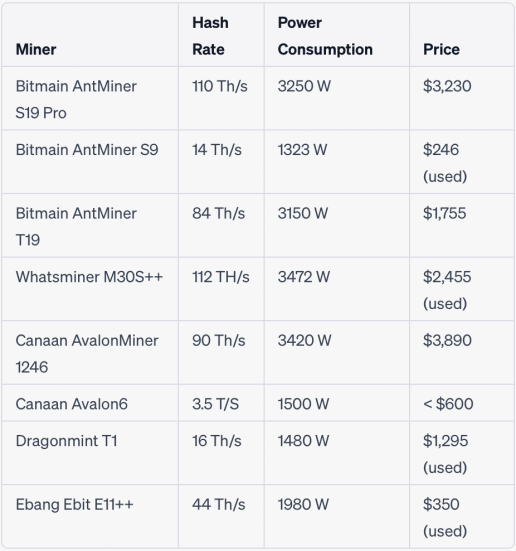
Source: CoinLedger
Mining Software
Miners use specialty software tailored for Bitcoin mining, which allows them to connect their hardware to the Bitcoin network. This software communicates with the Bitcoin protocol, receives new transactions and blocks, and performs the necessary computations to find a valid hash that meets the mining difficulty requirements. Examples of popular mining software include CGMiner, BFGMiner, and EasyMiner.
Many miners choose to join mining pools, which are groups of miners that combine their computational power (hash) to increase their chances of winning the next block. In mining pools, miners collaborate to solve cryptographic puzzles and distribute block rewards among pool participants if a solution is found. Joining a mining pool allows miners to have more consistent earnings and improved opportunities to earn rewards, although they will receive a smaller share of the rewards. A list of mining pools can be found here.
Bitcoin Mining Infrastructure
In addition to hardware and software requirements, mining requires internet connectivity, electricity, space for a mining setup, and the knowledge to maintain and monitor equipment.
Stable internet connectivity is crucial for receiving updates and participating in mining, while significant electricity consumption and heat generation require proper cooling systems. The physical space needed for mining setups varies based on the size and requirements of a mining operation. Mining operators are also responsible for performing maintenance, software updates, and monitoring to ensure optimal performance, efficiency, and profitability.
If a miner experiences downtime due to intermittent electrical or internet connectivity, or damage to hardware from overheating, they effectively seize its contribution to the mining process. This ultimately makes miners ineligible to mine new blocks and earn block rewards until they return online.
Lastly, a Bitcoin wallet that supports mining rewards is necessary. There are various kinds of wallets on the market today, including hardware (cold), software (hot), and online (hot) wallets. A couple of popular options include Electrum and Exodus.
The distinction between hot and wallets is an important one as it distinguishes its inherent security features. Hot wallets are connected and have less user friction but higher security risks. Cold wallets are offline or disconnected, improving security measures that favor low-usage users.
Is Bitcoin Mining Profitable? Block Rewards and Bitcoin Halving
Several factors like bitcoin price, hash rate, energy consumption, mining hardware, operational costs, block rewards, and transaction fees determine the profitability of mining bitcoin. However, due to the breadth of information, we'll focus on block rewards below.
Bitcoin Block Rewards
The miner or mining pool that successfully mines a new block is rewarded with the current block subsidy and the corresponding transaction fees validated in each block. These are the two components that comprise block rewards.
The block subsidy a miner earns is in the form of newly minted bitcoin (essentially, miners receive a Bitcoin reward). Currently, subsidies are fixed at 6.25 bitcoins per block, which is reduced every four years as part of an embedded mechanism called the Bitcoin halving. Bitcoin halving events are a key piece of the history of Bitcoin, as they reduce the number of new BTC entering the network and ensure that the total supply of BTC never exceeds 21 million bitcoin (the upper supply limit set by Satoshi when they created Bitcoin). The next halving occurs in 2024 where subsidies will be cut in half to 3.125 bitcoins per block, thereby reducing the reward for mining.
Users who want their transactions prioritized and confirmed could voluntarily attach fees to incentivize miners to include their transactions in the next block.
Block rewards are the primary driver in mining profitability, directly contributing to revenue generation. However, as block subsidies decrease over time due to halving events, miners will increasingly rely on transaction fees to maintain profitability. Miners must also ensure that their bitcoin mining operations utilize the most economical energy and efficient hardware to improve profitability.
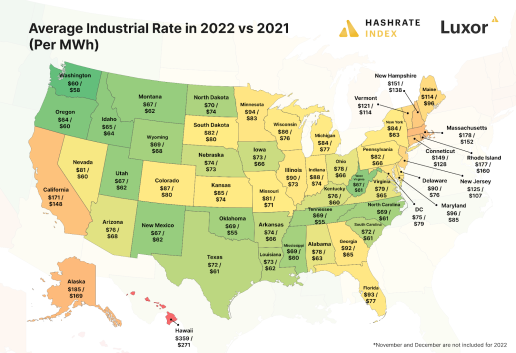
Source: Hashrate Index
For anyone considering mining in the United States, it’s important to note which state offers favorable cost per MWh, an important factor towards profitability.
Does Bitcoin Mining Difficulty Change Over Time?
The mining difficulty adjustment in Bitcoin is a mechanism designed to maintain a consistent block generation time and ensure the security and stability of the network. It takes place every 2016 blocks, approximately every two weeks, and is based on the total computational power of the network, known as the hash rate. The adjustment aims to keep the average block time close to the target of 10 minutes.
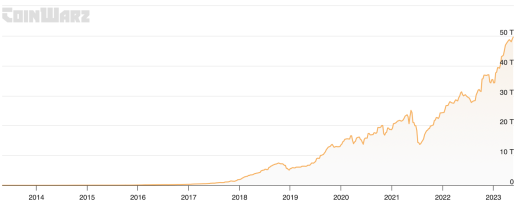
Source: Coin Warz
The difficulty increases in the next adjustment period when blocks are mined faster than the target time, indicating a higher hash rate. As a result, this makes finding a valid block solution more difficult and ensures that new blocks are added slowly. Conversely, if blocks are mined slower than the target time, indicating a lower hash rate, the difficulty decreases, making it easier for miners to find valid solutions.
By adjusting the difficulty, the network seeks to maintain a stable issuance of new bitcoins and prevent any single entity from dominating the mining process. It promotes fairness among miners and helps to secure the network against potential attacks. The difficulty adjustment is a fundamental aspect of Bitcoin's consensus mechanism and plays a crucial role in maintaining the integrity of the blockchain.
What are the Potential Impacts of Bitcoin Mining?
The Bitcoin mining industry has faced criticism for its significant energy consumption, prompting discussions about transitioning from PoW to proof-of-stake (PoS) consensus mechanisms to reduce the carbon footprint. However, mining operators are actively adopting alternative energy sources, such as hydroelectric, wind, and solar power, to mitigate reliance on fossil fuels.
Another emerging trend is the utilization of natural gas flares, which are excess or unwanted gases, as an energy source. Scaling the usage of renewable energy and alternative solutions is a work in progress as it battles to help address environmental concerns and ensure the industry operates more sustainably.
Bitcoin Miners: A Key Role in the History of Bitcoin
Needless to say, Bitcoin miners and the mining process have been integral to the growth of the blockchain since Bitcoin's inception. Mining has become a way for users to directly participate in the ecosystem and ensure that Bitcoin continues to develop.
While there are seemingly a number of factors that could affect the Bitcoin mining economy in the future (such as Bitcoin halving and the reduction of block rewards), a number of recent developments have not only shown the wider crypto space the potential value of Bitcoin as a blockchain to build upon, but have also provided possible incentives for miners to continue mining bitcoin (Bitcoin Ordinals being one of them).
Their long-term effect on the mining economy, however, remains to be seen and all eyes will be on next year's Bitcoin halving. Though the 2024 halving event won't necessarily have a substantial impact on the price of bitcoin, it will still be a key milestone to watch for Bitcoin miners.

